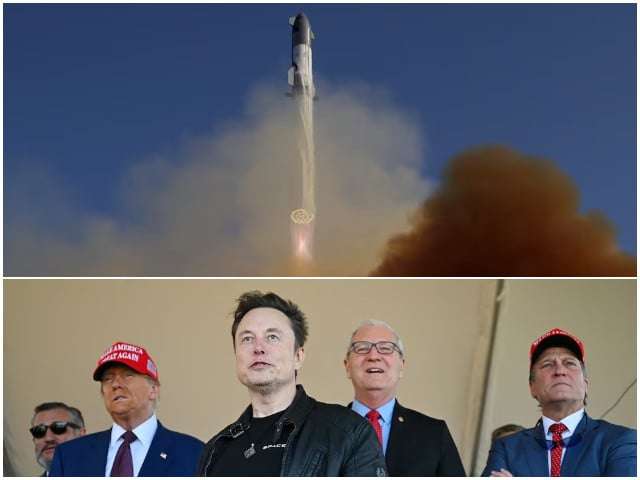On November 19, 2024, SpaceX successfully advanced its space exploration capabilities with the launch of its next-generation Starship spacecraft atop the Super Heavy rocket. This marks a significant milestone in the company’s goal to revolutionize space travel, despite an unexpected setback in the booster landing sequence. The event, held at the company’s Boca Chica launch facility in Brownsville, Texas, attracted high-profile attention, including the presence of U.S. President-elect Donald Trump, who strongly supports the ambitions of SpaceX and its CEO Elon Musk.
SpaceX’s Ambitious Starship Launch
SpaceX’s Starship rocket system, which stands at a staggering 400 feet (122 meters) tall, is designed with an eye toward future missions to the Moon, Mars, and beyond. The system, which consists of the powerful Super Heavy booster and the upper-stage Starship spacecraft, represents the company’s most ambitious project to date. The rocket launched at 4:00 p.m. CT (2200 GMT) from Boca Chica, carrying the hopes of the company’s long-term space exploration goals.
The mission, which was the sixth test flight of Starship, aimed to test several key systems, including the spacecraft’s ability to reignite its engines in space, a crucial step for future space missions. While the spacecraft performed well in achieving this and other milestones, the booster did not successfully return to the launch tower, as was initially planned.
A Successful Launch But a Setback in the Booster Recovery
As the Starship rocket lifted off, the Super Heavy booster successfully separated from the spacecraft at an altitude of around 40 miles (62 kilometers), sending Starship on its trajectory toward space. However, while the upper-stage spacecraft continued its journey, the Super Heavy booster did not land as planned.
Instead of returning to the launch site’s mechanical arms for a controlled landing, the booster splashed down in the Gulf of Mexico, which indicated an issue with its landing sequence. The event was captured on a separate livestream, showing the booster exploding in a fiery explosion upon hitting the water. Despite this setback, the mission’s overall success was still celebrated, as the Starship spacecraft was able to complete several critical objectives.
Key Achievements Despite the Booster Failure
Although the booster landing did not go as planned, the Starship mission achieved multiple key milestones that are crucial for the spacecraft’s future development. One of the most notable successes was the successful reignition of Starship’s space-adapted engine. This was the first time this engine was reignited in space, marking a significant achievement for the spacecraft’s manoeuvrability during in-space operations.
The spacecraft continued its journey, splashing down in the Indian Ocean approximately one hour after launch. NASA Administrator Bill Nelson publicly congratulated SpaceX, emphasizing that the engine reignition was a key step toward achieving orbital flight for Starship, which is vital for the company’s goals of deep space exploration.
Strengthening SpaceX’s Ties with the U.S. Government
The November 2024 launch also highlighted the growing relationship between SpaceX’s CEO, Elon Musk, and U.S. President-elect Donald Trump. Trump, who attended the launch, has long been an advocate of Musk’s space ventures, particularly the Starship program. His support of SpaceX is well-known, and he has been a vocal champion of Musk’s innovative approaches to space technology.
The presence of Trump at the launch signals not only personal support but also suggests that SpaceX may benefit from favorable policies under the new administration. Trump’s enthusiasm for the space industry is evident, and his support of Musk and his endeavors is likely to lead to increased collaboration between the private sector and the U.S. government.
Musk has been a prominent figure in Trump’s administration, providing financial backing for his campaign and playing an active role in government initiatives. Musk was appointed to co-lead a government efficiency initiative aimed at reducing waste and cutting down on regulatory burdens, which aligns with SpaceX’s goal of speeding up its operations.
Streamlined FAA Approval for SpaceX’s Launch
One of the key challenges SpaceX has faced in recent years is the regulatory environment, particularly with the Federal Aviation Administration (FAA). Musk has been outspoken about the FAA’s slow approval processes, which he believes hinder SpaceX’s progress. However, the approval for this launch came quickly, with the FAA granting permission in record time. This marked the fastest regulatory turnaround for SpaceX to date, which could signal a shift toward more streamlined and supportive regulatory frameworks for private space companies under the new administration.
The Goals of Starship and SpaceX’s Future Plans
The Starship mission was not only a test flight but also part of SpaceX’s broader goals for rapid development in the coming years. The company has set its sights on achieving some of the most ambitious goals in space exploration, with plans to develop a spacecraft capable of carrying humans to the Moon and Mars. Starship is designed to be a fully reusable spacecraft, which is a key aspect of SpaceX’s vision to reduce the cost of space travel and make space more accessible.
Musk has long stated that one of his ultimate goals is to create a self-sustaining colony on Mars. This test flight brings SpaceX one step closer to realizing that dream, with the successful reignition of the spacecraft’s engines serving as a critical step in the development of technology needed for deep space travel.
SpaceX’s Plan for Starship’s Future: 400 Launches in Four Years
SpaceX President Gwynne Shotwell has indicated that the company plans to accelerate its Starship development with the goal of achieving as many as 400 Starship launches over the next four years. This ambitious target is on par with the milestone reached by SpaceX’s Falcon rocket fleet, which has seen rapid launches and increasing success in recent years.
This aggressive development timeline is further supported by the Trump administration, which is expected to prioritize space exploration through initiatives such as NASA’s Artemis program. The Artemis program aims to return humans to the Moon and establish a sustainable presence there, with long-term goals for Mars exploration. SpaceX’s Starship is expected to play a significant role in these missions, as it is one of the few spacecraft capable of supporting long-duration space travel.
SpaceX’s Long-Term Impact on Space Exploration
SpaceX’s Starship project is poised to have a transformative effect on space exploration. With its revolutionary design, rapid development plans, and strong support from the U.S. government, Starship could become the cornerstone of future space missions. From lunar landings to Mars exploration, the potential applications of Starship are vast and varied.
The ultimate success of the Starship program, while still a few years away, could mark the beginning of a new era in human space exploration. By significantly reducing the cost of space travel and making deep space exploration more accessible, SpaceX is poised to change the landscape of space technology and exploration forever.
FAQs
1. What was the main goal of SpaceX’s Starship launch on November 19, 2024?
The main goal was to test the spacecraft’s engine reignition in space, perform an ocean landing, test higher reentry temperatures, and accelerate booster recovery.
2. Why did the Super Heavy booster fail to land?
The booster failed to land as planned due to an issue during its landing sequence, causing it to splash down in the Gulf of Mexico, where it exploded upon impact.
3. What milestones did the Starship mission achieve despite the booster landing failure?
Starship successfully reignited its engine in space, marking an important step in its maneuverability during future space missions. The spacecraft later splashed down in the Indian Ocean, completing its objectives.
4. How does SpaceX’s Starship contribute to NASA’s Artemis program?
Starship is designed to be a fully reusable spacecraft capable of carrying humans to the Moon and Mars, which directly aligns with NASA’s Artemis program for lunar exploration and long-term Mars missions.
5. How many Starship launches does SpaceX plan over the next few years?
SpaceX plans to conduct up to 400 Starship launches over the next four years, a goal that mirrors the launch frequency of its Falcon rocket fleet.
ALSO READ:



